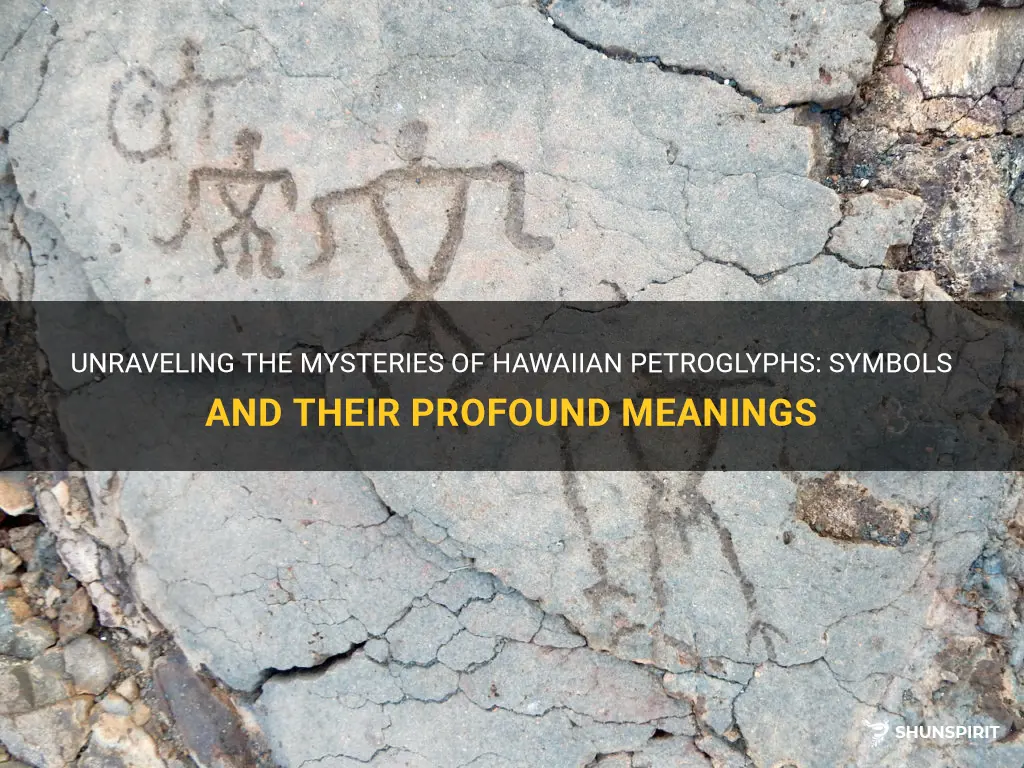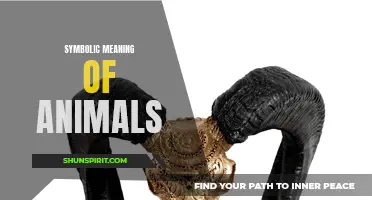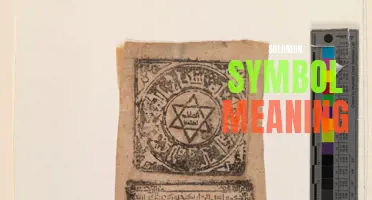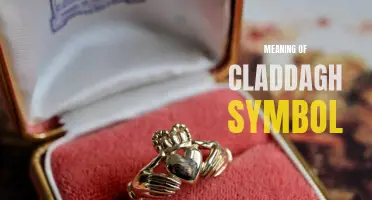
Hawaii is known for its breathtaking beaches, lush landscapes, and rich cultural heritage. One of the most fascinating aspects of Hawaiian culture is the petroglyphs, ancient rock carvings that offer a glimpse into the past. These intricate symbols hold deep meanings, telling stories of the island's history, spirituality, and everyday life. From depictions of mythical creatures to images of people engaged in various activities, Hawaiian petroglyphs offer a window into a world long gone, sparking curiosity and wonder among those who encounter them. Join us on a journey to discover the hidden meanings of these captivating symbols, and unlock the secrets of Hawaii's ancient past.
What You'll Learn
- What are some common symbols found in Hawaiian petroglyphs?
- What is the significance and meaning behind these symbols in Hawaiian culture?
- How have the interpretations of Hawaiian petroglyph symbols evolved over time?
- Are there any specific petroglyph sites in Hawaii that are particularly important or sacred?
- How do Hawaiian petroglyph symbols compare to petroglyphs found in other ancient cultures around the world?

What are some common symbols found in Hawaiian petroglyphs?
Hawaiian petroglyphs are ancient rock carvings that can be found throughout the Hawaiian Islands. These carvings are believed to have been created by the indigenous people of Hawaii, known as the Kanaka Maoli, and can provide insight into their culture and history.
One of the most common symbols found in Hawaiian petroglyphs is the human figure. These figures can vary in size and shape, and often depict people engaged in different activities such as fishing, farming, or dancing. The human figure in these carvings is believed to represent the ancestors of the Kanaka Maoli and serve as a connection between the past and present.
Another common symbol found in Hawaiian petroglyphs is the turtle. The turtle is a symbol of longevity and is considered a sacred animal in Hawaiian culture. The petroglyphs featuring turtles often depict them in different positions, such as swimming or laying eggs. These carvings are believed to represent the importance of the ocean and its creatures to the Kanaka Maoli.
The canoe is another common symbol found in Hawaiian petroglyphs. Canoes were an essential part of the Hawaiian way of life, used for transportation, fishing, and exploration. The petroglyphs featuring canoes often depict them in different sizes and styles, representing the various types of canoes used by the Kanaka Maoli.
The fish is also a common symbol found in Hawaiian petroglyphs. Fishing was an important activity for the Kanaka Maoli, providing them with food and resources. The petroglyphs featuring fish often depict them in different shapes and sizes, representing the various species found in Hawaiian waters.
Other common symbols found in Hawaiian petroglyphs include plants, such as coconut trees and taro plants, which were important sources of food and materials for the Kanaka Maoli. Additionally, symbols representing the sun, moon, and stars can be found, symbolizing the connection between the heavens and the earth.
In conclusion, Hawaiian petroglyphs are rich in symbolism and provide a glimpse into the culture and history of the Kanaka Maoli. The common symbols found in these carvings, such as human figures, turtles, canoes, fish, plants, and celestial bodies, are a testament to the importance of these elements in Hawaiian life. By studying these petroglyphs, we can gain a deeper understanding of the indigenous people of Hawaii and their connection to the land and sea.
Understanding Massey Ferguson Tractor Dashboard Symbols and Meanings
You may want to see also

What is the significance and meaning behind these symbols in Hawaiian culture?
Hawaii is a land known for its rich cultural heritage and deep-rooted traditions. One of the most fascinating aspects of Hawaiian culture is its extensive use of symbols and their deep meanings. These symbols are an important part of Hawaiian life and can be seen in various forms, including art, tattoos, and jewelry. In this article, we will explore the significance and meaning behind some of the most iconic symbols in Hawaiian culture.
One of the most recognizable symbols in Hawaiian culture is the hibiscus flower. This vibrant flower is the state flower of Hawaii and represents the natural beauty of the islands. It is often used in Hawaiian art and is a popular choice for tattoos and jewelry. The hibiscus flower symbolizes power, glory, and feminine beauty.
Another important symbol in Hawaiian culture is the sea turtle, known as “honu” in Hawaiian. The sea turtle is considered a sacred creature and is believed to bring good luck, long life, and fertility. It is also seen as a symbol of wisdom and protection. Many Hawaiians believe that sea turtles are their ancestral guardians and that they bring positive energy and guidance.
The “kukui nut” is another significant symbol in Hawaiian culture. The kukui tree, also known as the candlenut tree, is native to Hawaii and its nuts have been used for medicinal and cultural purposes for centuries. In Hawaiian culture, the kukui nut represents enlightenment, knowledge, and protection. It is often worn as jewelry or used in traditional Hawaiian ceremonies.
The “maile lei” is a type of lei made from the leaves of the maile plant. It is highly treasured in Hawaiian culture and is often given as a sign of respect and honor. The maile lei is associated with sacred ceremonies, such as weddings, blessings, and rites of passage. It symbolizes unity, love, and spiritual connection.
The “octopus” is another important symbol in Hawaiian culture, known as “heʻe” in Hawaiian. The octopus is highly revered and is believed to possess great intelligence and adaptability. It is seen as a symbol of strength, flexibility, and resilience. In Hawaiian mythology, the octopus is often associated with the creation of the islands and is considered a guardian of the ocean.
The “tiki” is a distinctive and iconic symbol in Hawaiian culture. The tiki represents the first human being in Hawaiian mythology and is believed to be the ancestor of all humans. It is often depicted as a carved wooden idol or mask and is considered a protector and guardian. The tiki symbolizes strength, fertility, and a connection to the spiritual world.
These symbols, along with many others, play a significant role in Hawaiian culture and are deeply respected and cherished by the people of Hawaii. They represent the values, beliefs, and traditions that have been passed down through generations. Whether seen in artwork, tattoos, or jewelry, these symbols are a visual reminder of the rich cultural heritage of Hawaii and the important role they play in the lives of its people.
Decoding Kubota Tractor Dashboard Symbols: Understanding their Meanings
You may want to see also

How have the interpretations of Hawaiian petroglyph symbols evolved over time?
The Hawaiian petroglyphs, also known as Ki'i Pohaku, are ancient rock carvings that hold great cultural and historical significance. These petroglyphs can be found on the island of Hawaii and serve as a visual record of the traditions and beliefs of the ancient Hawaiian people. Over time, the interpretations of these symbols have evolved, providing new insights into the rich history of the Hawaiian culture.
The earliest interpretations of Hawaiian petroglyph symbols were primarily based on the understanding and knowledge of the native Hawaiian people. These interpretations were often passed down through generations, with the meanings of the symbols being shared through oral traditions. For example, a petroglyph symbol depicting a human figure with outstretched arms was believed to represent a hula dancer or a warrior.
However, as Western influences began to shape the cultural landscape of Hawaii, new interpretations of the petroglyph symbols emerged. Scholars and archaeologists started to study these carvings, attempting to decode their meanings based on their own cultural perspectives. This led to a shift in the understanding of the petroglyph symbols, as they were analyzed through the lens of Western theories and ideologies.
One of the early Western interpretations of Hawaiian petroglyph symbols was that they represented a form of written language. Some researchers believed that these symbols were a primitive form of writing, similar to hieroglyphics, and attempted to decipher their meanings accordingly. However, this interpretation has since been largely discredited, as it became evident that the petroglyphs did not follow a consistent structure or syntax that could be considered a true written language.
In recent years, a more nuanced and culturally sensitive approach to interpreting Hawaiian petroglyph symbols has emerged. This approach recognizes the importance of incorporating traditional Hawaiian knowledge and perspectives into the analysis, alongside Western archaeological methods. By engaging with native Hawaiian elders and cultural experts, researchers have been able to gain new insights into the meanings behind these ancient carvings.
One significant development in the interpretation of Hawaiian petroglyph symbols is the focus on their cultural context. Rather than attempting to assign universal meanings to each symbol, scholars have come to understand that the significance of these carvings can vary depending on their location, surrounding landscape, and the cultural practices of the time. For example, a petroglyph symbol depicting a fisherman may hold different connotations if it is found near a fishing village as opposed to an agricultural site.
Another important aspect of the evolving interpretations of Hawaiian petroglyph symbols is the recognition of their spiritual and symbolic significance. Many of these symbols are believed to embody the mana, or spiritual power, of the ancient Hawaiian people. They serve as a connection to the past and a reminder of the deep spiritual beliefs and practices of the native culture. By studying these symbols and their placement within the landscape, researchers have gained a deeper understanding of the spiritual significance of these carvings.
In conclusion, the interpretations of Hawaiian petroglyph symbols have evolved over time, moving from traditional indigenous understandings to Western theories and back to a more culturally sensitive approach that incorporates both perspectives. These petroglyphs continue to fascinate and intrigue researchers, offering valuable insights into the history and cultural practices of the ancient Hawaiian people. By recognizing their cultural context and spiritual significance, we can continue to learn from and honor the legacy of these remarkable rock carvings.
Decoding the Bobcat Warning Light Symbols: Understand Their Meanings
You may want to see also

Are there any specific petroglyph sites in Hawaii that are particularly important or sacred?
Hawaii, a beautiful archipelago known for its stunning landscapes and rich cultural history, is home to several important and sacred petroglyph sites. These ancient rock carvings offer a glimpse into the lives and beliefs of Hawaii's indigenous people and hold significant cultural and spiritual value.
One of the most well-known and revered petroglyph sites in Hawaii is the Pu'u Loa Petroglyphs. Located within the Hawaii Volcanoes National Park on the Big Island, this ancient art gallery contains over 23,000 individual petroglyphs etched into the hardened lava flows. The site is believed to be a sacred place where native Hawaiians would come to leave their mark, often in connection with important life events such as the birth of a child or the death of a loved one. Visitors are encouraged to show respect and refrain from touching or defacing the carvings.
Another notable petroglyph site in Hawaii is the Waikoloa Petroglyph Field, also on the Big Island. This expansive field, located near the Waikoloa Beach Resort, features over 1,200 petroglyphs spread across a vast expanse of ancient lava rock. The carvings depict a variety of shapes, symbols, and figures, many of which are believed to represent deities, animals, and important events in Hawaiian mythology. The site is considered to be of great cultural and historical significance and is protected by the state and local communities.
On the island of Oahu, the Nuuanu Petroglyph Park is another important petroglyph site. Situated in a lush, tropical forest in Honolulu, this hidden treasure contains around 56 petroglyphs dating back hundreds of years. The carvings here are thought to represent various aspects of Hawaiian life, including human figures, water and land animals, and celestial bodies. The park is open to the public, but visitors are reminded to be respectful and mindful of the site's cultural significance.
In addition to these specific sites, scattered petroglyphs can be found throughout the Hawaiian Islands. Many of these carvings are located in remote or restricted areas and may only be accessible with permission or on guided tours. It is important to remember that these petroglyphs are sacred to native Hawaiians and should be treated with the utmost respect. Visitors are encouraged to learn about the cultural and historical significance of these sites and to follow any guidelines or restrictions in place to preserve and protect them for future generations.
Visiting petroglyph sites in Hawaii offers a unique opportunity to connect with the ancient past of the islands and gain a deeper appreciation for the vibrant culture that continues to thrive today. These sacred sites serve as a reminder of the rich heritage of Hawaii and the importance of preserving and respecting its cultural treasures.
Understanding Forklift Dashboard Symbols and Meanings: A Guide for Operators
You may want to see also

How do Hawaiian petroglyph symbols compare to petroglyphs found in other ancient cultures around the world?
Hawaiian petroglyph symbols are a unique form of ancient rock art that can be found in the Hawaiian Islands. These symbols are believed to have been created by the Native Hawaiian people thousands of years ago and have served as a significant cultural and historical record of their society. While petroglyphs can be found in many ancient cultures around the world, Hawaiian petroglyph symbols exhibit distinct characteristics that set them apart from others.
One of the most noticeable differences between Hawaiian petroglyph symbols and those found in other ancient cultures is the imagery and subject matter depicted. In Hawaiian petroglyphs, common motifs include human figures, animals, plants, tools, and celestial objects. These symbols often represent important aspects of Hawaiian life, such as deities, ancestors, and activities related to farming, fishing, and navigation. This emphasis on the natural world and daily life is distinct from other cultures where symbols might focus on religious rituals, mythological stories, or warfare.
Another notable feature of Hawaiian petroglyph symbols is their simple and abstract style. Unlike other ancient cultures that might depict detailed and realistic human and animal figures, Hawaiian petroglyphs tend to use basic shapes and lines to represent various objects and beings. This minimalist approach creates a sense of universality and allows for multiple interpretations, allowing viewers to project their own meaning onto the symbols.
Furthermore, the location and positioning of Hawaiian petroglyph symbols also contribute to their uniqueness. Many of the petroglyphs in Hawaii can be found in coastal areas, specifically on volcanic rock formations and lava flows. This placement is significant as it connects the symbols with the natural environment and the powerful forces of creation and destruction associated with volcanic activity. In contrast, petroglyphs in other ancient cultures are often found in various landscapes, such as caves, canyons, or desert plains, each with its own significance and context.
Despite these differences, it is also important to note that there are some similarities between Hawaiian petroglyph symbols and those found in other ancient cultures. For example, both Hawaiian petroglyphs and petroglyphs from Native American cultures often utilize geometric patterns and symbols to convey meaning. Additionally, the act of creating petroglyphs itself transcends cultural boundaries, as it represents a universal human impulse to communicate and leave a lasting mark on the world.
In conclusion, while Hawaiian petroglyph symbols share some similarities with petroglyphs found in other ancient cultures, they also exhibit distinct characteristics that differentiate them. The imagery, style, and positioning of Hawaiian petroglyph symbols highlight their connection to the natural world, daily life, and volcanic landscapes of Hawaii. By studying and understanding these unique symbols, we can gain valuable insights into the history, culture, and beliefs of the Native Hawaiian people.
Understanding the Symbol and Dash Light Meanings in John Deere Tractors
You may want to see also
Frequently asked questions
Hawaiian petroglyphs are ancient rock carvings found throughout the Hawaiian Islands. These carvings depict various symbols and figures that hold cultural and spiritual significance to the indigenous people of Hawaii.
The meaning of each symbol on Hawaiian petroglyphs can vary depending on the specific carving and its context. However, many of these symbols are believed to represent important aspects of Hawaiian culture, such as fertility, protection, ancestral lineage, and navigation.
Hawaiian petroglyphs were created by the indigenous people of Hawaii using stone tools. These tools were used to carve intricate designs into the volcanic rock surfaces found throughout the islands. The carvings were often made by repeatedly striking the rock's surface with the sharp edge of the stone tool.
Hawaiian petroglyphs can be seen at various sites throughout the Hawaiian Islands. One of the best places to view these carvings is at the Pu'u Loa Petroglyphs in Hawaii Volcanoes National Park on the Big Island. Other sites include Waikoloa Petroglyphs in Waikoloa Village and the Kaloko-Honokohau National Historical Park on the Kona coast of the Big Island. It is important to remember that these petroglyphs are sacred and should be respected by visitors.







